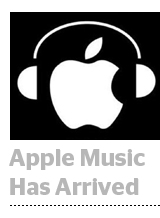 The music streaming space got a bit more crowded on Tuesday with the launch of Apple Music, rivaling streaming services like Spotify, Pandora and Google Play. But as the war to win audiences escalates, questions about Apple’s model linger.
The music streaming space got a bit more crowded on Tuesday with the launch of Apple Music, rivaling streaming services like Spotify, Pandora and Google Play. But as the war to win audiences escalates, questions about Apple’s model linger.
After a three-month free trial, Apple Music will become a subscription-based platform for a monthly fee of $9.99. But lack of ad-supported models could be a problem for Apple, according to data from business consultation firm Strategy Analytics that indicates consumers don’t want to pay to stream music.
Strategy Analytics predicts that while mobile music-streaming audiences will grow from 320 million in 2014 to 808 million in 2021, only 11% of listeners will be subscription-monetized and 89% will be ad-monetized.
Spotify, which has more than 75 million users, and only 20 million paid subscribers who don’t hear ads, is the exception, said Pat Higbie, CEO of interactive audio firm XAPPmedia.
“Companies like Spotify have driven subscription rates higher,” Higbie said. “But they’re the leader in subscription percentages as far as total listenership. If you look across the board, only 5% of Pandora’s 80 million listeners pay a subscription fee.”
Despite struggling to boost revenues in recent quarters, Pandora stands by its ad-supported model, said Pandora co-founder Tim Westergren.
“Ad-supported radio is a powerful and essential promotional tool for expanding any music maker’s audience and delivering a fantastic experience to listeners,” he said. “Apple’s investment in the streaming music category at large simply reinforces our long-held belief that there is healthy consumer demand for these types of services.”
Apple might be playing up its subscription model because it’s playing up to music labels, whose download revenues are being cannibalized by streaming services.
“The labels think that if you turned off ad-supported streaming all together, people are going to start downloading music again,” Higbie said, adding that such a scenario won’t happen.
“But the good thing is that audio advertising is going to be better than it ever has been because the content consumption model for audio is phenomenal. People can listen to audio while they’re doing other things.”
David Kert, COO of TargetSpot, a digital audio advertising platform, agreed that ad-supported models are an industry mainstay.
AdExchanger Daily
Get our editors’ roundup delivered to your inbox every weekday.
Daily Roundup
“Ad-supported models are not going away anytime soon,” Kert said. “And with all the ways people can listen to digital music and the amount of time spent listening, ad tech will continue to connect advertisers with digital audio listeners.”
Although not widely reported, sources said Apple could be plotting an ad-supported model baked into its offering with Beats 1 Radio, an international radio streaming station which will sit inside Apple Music.
And a counterattack from Google last week, when it launched an ad-supported listening platform to complement its existing subscription-based service, may convince Apple to do just that.
“Google is going to draw advertisers faster because they’ve already seen what happens in the subscription-only model,” said Higbie. “If Apple wants to grow subscriptions, they have to grow ad-supported listening.”
While free streaming services could entice consumers to test Google’s offering, the winner of the streaming wars will ultimately be the company that can offer audiences the most compelling product. More than half of all Americans stream audio on a weekly basis, according to Edison Research, and Apple and Google will fight over that new audience growth in the months to come.
“Advertisers are going to follow the listeners,” Higbie said. He predicted that people love Spotify too much to simply jump ship, and that Apple and Google will simply increase the overall size of the market.













